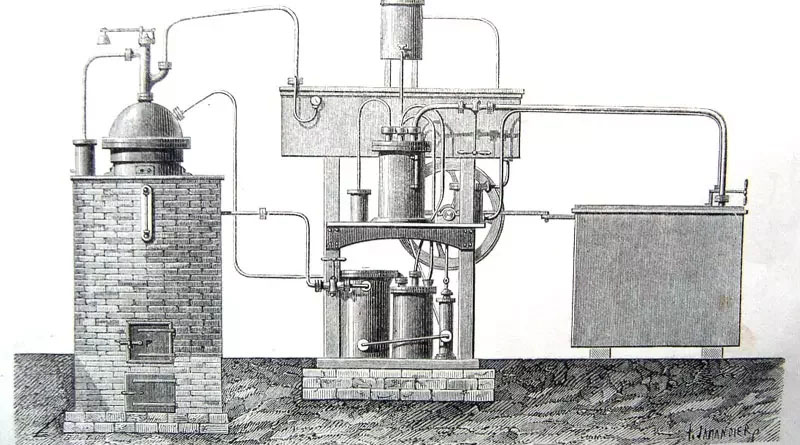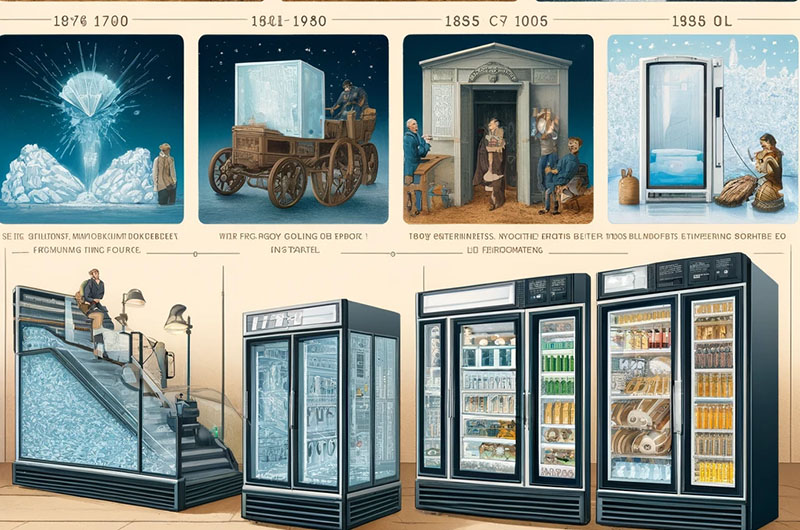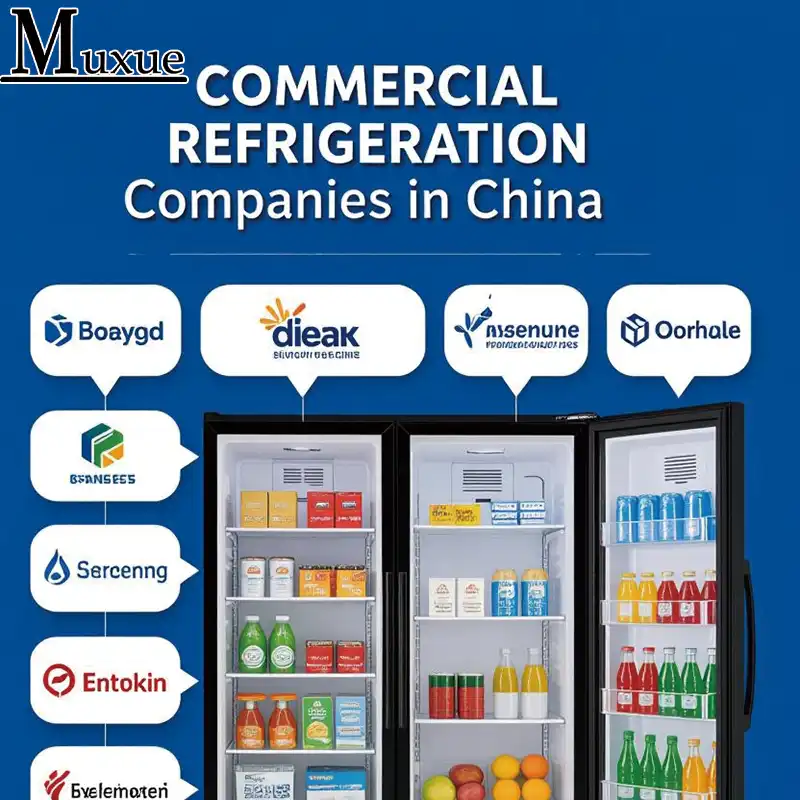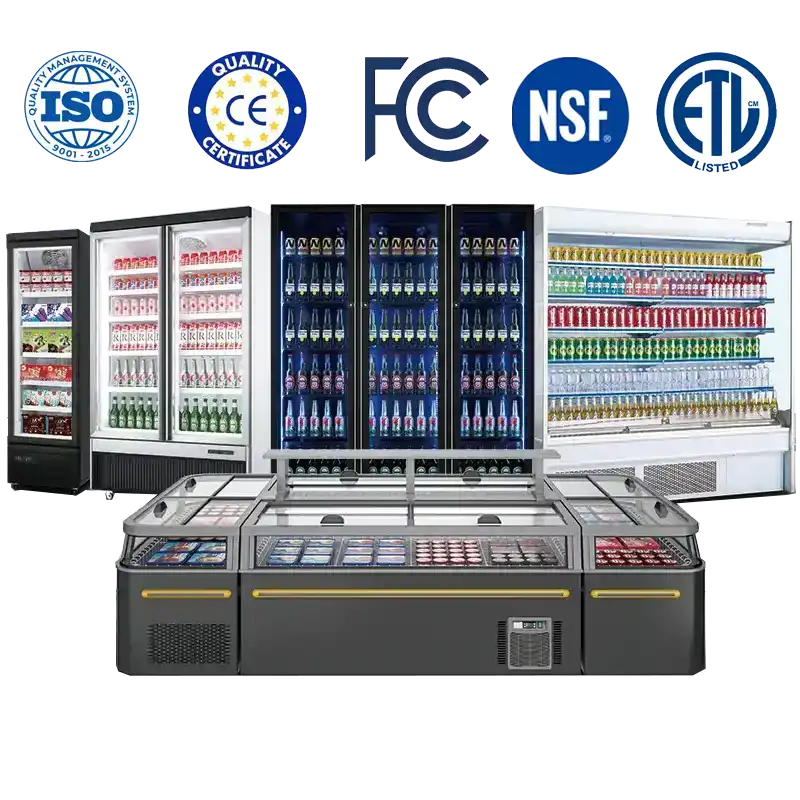The Evolution of Commercial Refrigeration Systems
A Journey from Ice Storage to Modern Cooling Solutions
Whether you own a convenience store, manage a grocery store, or run the kitchen of a restaurant, refrigeration units are likely essential to your day-to-day operations. Whether you’re cooling drinks for your on-the-go customers or preserving fresh meats, cheeses, and vegetables for the preparation of a delicious meal, commercial refrigerators are indispensable. The refrigeration systems used in modern businesses have evolved significantly from their early predecessors, progressing from rudimentary cooling techniques to advanced, energy-efficient, and highly functional units. Now let’s briefly introduce the History of Commercial Refrigeration.

The Origins of Refrigeration
Early Attempts and Breakthroughs
The concept of refrigeration dates back hundreds of years, with some of the earliest methods of cooling involving the storage of ice and snow. In ancient civilizations, ice was harvested from lakes and stored in specially designed buildings that kept it insulated from the heat. These early ice houses were constructed with thick walls made from straw and sawdust, providing natural insulation to keep ice frozen for long periods. While these buildings were a major advancement for their time, the idea of artificially producing cold was still a far-fetched notion.
Humans have depended on cooling for a long time. However, people who lived in hot climates didn’t have natural ice at their disposal. They had to get creative to stay comfortable. You could say that the ancient Egyptians invented the first window unit. They didn’t have electricity or the boxy units we use today, though. Instead, they would hang wet reeds on their windows. The water on the reeds would absorb heat from the warm wind, and cool air would enter the building.
We’ve also used refrigeration much longer than you probably expected. The people of ancient Persia and India used to make their own ice. They did it by merely leaving trays of boiled water out at night. Heat leaves the earth through the atmosphere, especially at night when the sun can’t add more heat. (That’s why you may have frost on your roof or car even though it’s not freezing outside.) The water would freeze due to heat loss.

The history of refrigeration spans centuries, evolving from natural preservation methods to modern technological innovations. Refrigeration involves maintaining low temperatures to preserve perishable items, with refrigerators typically operating between 35-38°F (1.6-3.3°C) and freezers at 0°F (-18°C).
Using ice or cold temperatures to preserve food has been a part of our daily lives since ancient times; even so, there was an ice trading industry only consumed by the wealthy for a time. From early ice trade practices to the development of mechanical refrigeration, the evolution and advancements of refrigeration systems have significantly impacted food storage, healthcare, and daily life.
Early methods included ice harvesting and storage in icehouses, leading to commercial ice machines and the widespread adoption of household refrigerators. Innovations like Freon, dual-temp designs, and energy-efficient systems have further transformed refrigeration, balancing efficiency and environmental sustainability.
In the 1700s, William Cullen, a Scottish chemist, made a groundbreaking discovery in the field of refrigeration. He demonstrated that evaporation could cause a cooling effect, marking the beginning of modern refrigeration principles. However, Cullen’s cooling box was not a practical invention at the time, as it lacked the technology to maintain a consistent and reliable cooling environment. Despite this, his work laid the groundwork for future innovations in the field.
In the following decades, Benjamin Franklin and John Hadley, an English chemist, further explored the concept of cooling by using volatile liquids, which could evaporate at lower temperatures. Although these experiments did not directly lead to the creation of commercial refrigeration systems, they provided key insights into the cooling process and would eventually lead to significant developments in refrigeration technology.
The Birth of Ice-Making Machines
The Mid-1800s and Early Commercial Use
Before the invention of refrigeration machines, traditional methods were used to keep food safe and prevent spoiling. Some methods of preserving food in ancient times were keeping food cold using ice, snow, or cold temperatures or dehydrating the food using salt.
Natural ice and snow were some of the natural resources used for cooling by ancient civilizations. Some early cooling methods were transporting ice from mountains, using cold rivers and lakes, and building storage pits filled with snow or ice. Ice houses were a popular and effective way of preserving food in locations where freezing temperatures were available. Opening pits in the ground, covering the food with snow, and covering the pits with straw or sawdust provided insulation and preserved the ice and snow for months.
Yakhchals are ice houses used by ancient Persians for ice storage and food preservation in early times. Yakchals are dome-shaped structures with underground storage made of thick, heat-resistant materials that can keep ice for a year.
The structures included shallow ice-making pools filled with water from qanats (freshwater canals) each night and shaded by walls up to six feet (1.828 m) thick to protect from the winter sun. The high shade of the wall protected the pool from direct sunlight, preventing the ice from melting. They were primarily built in Iran, where they kept ice produced on-site in winter or transported from mountains. Ice was harvested and stored in the yakhchals, often insulated with straw thatch. Like the one in Meybod, the domes were about 15 meters (49.212 ft ) tall and made from adobe with materials like mud, animal hair, and egg white. Records show that these structures were built as early as 400 BCE.
Salting and spicing were two early methods of preserving food before mechanical refrigeration. The preservation properties of salt were first realized by ancient Egyptians and used for centuries in many parts of the world. Dehydrating food using raw salts derived from rock, sea, lake, etc., removes moisture from food, inhibiting microbial growth and preventing spoilage. There are two types of salting to preserve foods. Dry salting is applying salt directly to the surface of the food, mostly used for meats and fish. Brining is submerging food in a saltwater solution, allowing for more uniform salt distribution. It is mostly used to preserve pickles, olives, and some cheese.
By the mid-1800s, advancements in refrigeration technology began to take shape. Ferdinand Carre, a French engineer, is credited with developing the first practical refrigeration machine capable of producing ice. In 1859, Carre’s machine used ammonia to absorb heat and produce ice, which revolutionized the way ice was produced and used in commerce.
At the time, New Orleans relied heavily on ice shipments from New England, but when this supply was cut off, three of Carre’s machines were transported to the city to solve the problem. This marked one of the first major uses of commercial refrigeration technology, as it allowed for the production of ice locally rather than depending on external sources.
Throughout the 1800s, more innovations emerged. In the 1840s, refrigerated boxcars were introduced to transport perishable goods like dairy products, helping to extend the shelf life of these items. These refrigerated railcars were a significant development, as they allowed for the long-distance transportation of food, something that was previously impossible due to the limited storage capabilities of early transportation methods.
By the late 1800s, ships began to incorporate refrigeration units, allowing for the transportation of frozen food over long distances. This opened up international trade for perishable goods like meat, fruits, and vegetables, revolutionizing the global food industry.
The Birth of Mechanical Refrigeration
In 1755, William Cullen, a Scottish professor, invented an early mechanical refrigeration system using a vacuum to lower the boiling point of diethyl ether, which absorbed heat from the air. Although this was a significant scientific advancement, it had no practical applications.
Fifty years later, American inventor Oliver Evans expanded on Cullen’s principles by conceptualizing a closed vapor-compression cycle, which showed how vapor could be used to cool. However, a practical model wasn’t built until 1835 by Jacob Perkins, the father of the modern refrigerator. His system demonstrated the potential for cooling air in a closed cycle.
In 1851, James Harrison improved the technology by using refrigerants like ether, alcohol, or ammonia, which allowed the reuse of the cooling agent and enabled temperatures below freezing. His compressor forced the gas through a condenser where it cooled and liquefied, then vaporized in coils, cooling the surroundings. This compression cycle was crucial in the brewing and meat-packing industries, providing consistent cooling and paving the way for modern refrigeration.
The Rise of Commercial Refrigeration
The Early 1900s
In the early 1900s, commercial refrigeration systems became indispensable in various industries, particularly in the meat-packing industry. Large companies like Armour and Wilson started to adopt refrigeration technology to store and transport meat products. These companies purchased refrigeration units to be used in boxcars and storage facilities to maintain the freshness of their products during transport and storage.
The refrigeration units used in this era were colossal, often weighing between five and two hundred tons. These early systems were powered by toxic gases, such as ammonia and sulfur dioxide, which were used as refrigerants to cool the air. While these systems were highly effective in cooling, they were also dangerous due to the hazardous nature of the gases used. The risks associated with the use of these chemicals posed a significant threat to workers and anyone in proximity to the equipment.
Despite the safety concerns, the demand for refrigeration continued to grow as industries recognized the importance of preserving perishable goods. This led to increased investments in refrigeration technologies, which would eventually result in safer, more efficient, and affordable systems.
The 20th Century
A Century of Innovation and Accessibility
As the 20th century progressed, significant advancements were made in refrigeration technology. The development of more efficient, lightweight, and affordable refrigeration systems made them more accessible to a wider range of industries, including supermarkets, restaurants, and convenience stores. These innovations transformed refrigeration from a luxury used by large corporations into an essential tool for businesses of all sizes.
In the 1920s and 1930s, refrigeration systems began to incorporate safer and more environmentally friendly refrigerants. Previously, refrigeration units relied on ammonia, sulfur dioxide, and other toxic gases to cool the air. However, these gases posed significant risks to human health and the environment. In response to these concerns, researchers developed new refrigerants, such as Freon, which was less toxic and more efficient. The use of Freon revolutionized refrigeration, making it safer and more widely adopted.
In the mid-20th century, commercial refrigerators began to shrink in size and become more energy-efficient. Manufacturers started designing smaller, more compact units that could be easily integrated into various businesses, including grocery stores, hotels, and restaurants. These smaller units were not only more affordable but also more versatile, making them ideal for businesses with limited space.
Additionally, the introduction of digital thermostats and temperature control systems allowed businesses to maintain more precise control over the internal temperature of refrigeration units. This helped to ensure the quality and safety of perishable goods, reducing food waste and increasing profitability for businesses.
The Modern Era
Energy-Efficient and Smart Refrigeration Systems
Today, commercial refrigeration systems have become more advanced, energy-efficient, and user-friendly than ever before. Modern refrigeration units are designed with a variety of features that not only improve performance but also enhance the overall user experience.
One of the most significant advancements in modern refrigeration is the development of energy-efficient systems. With rising energy costs and growing concerns about climate change, businesses have become increasingly focused on reducing their energy consumption. Manufacturers have responded by designing refrigeration units that use less energy while maintaining optimal cooling performance. These energy-efficient units not only help businesses save money on utility bills but also reduce their environmental footprint.
Another key development in modern commercial refrigeration is the integration of smart technology. Many new refrigeration units come equipped with digital temperature controls, remote monitoring systems, and even mobile apps that allow business owners to monitor and adjust their refrigeration systems from anywhere. These smart features provide greater flexibility and convenience for businesses, allowing them to manage their refrigeration systems more efficiently and ensure that perishable goods are stored at the ideal temperature.
Furthermore, modern refrigeration units are designed with advanced safety features that minimize the risks associated with refrigerants. The use of natural refrigerants, such as CO2 and hydrocarbons, has become more common in recent years, as these substances have a lower environmental impact than traditional synthetic refrigerants.
In terms of design, today’s commercial refrigerators are not only functional but also aesthetically appealing. Many units come with clear glass doors, LED lighting, and sleek, modern designs that make them more attractive to customers. This is particularly important in the retail and foodservice industries, where product visibility plays a key role in driving sales.
How did refrigeration spread?
Evolution and development
Among the first domestic refrigerators was the General Electric Audiffren made using the studies of a French monk by the name of Marcel Audiffren and dating from 1911. These refrigerators used sulphur dioxide as a refrigerant gas using a hermetic compressor.
There is also another device attributed to Fred W Wolf (1913) and marketed under the Domelere brand name. The price was exorbitant, almost 1000 dollars at the time, twice the price of a Ford T. In 1918 Frigidaire and Kelvinator began industrial production by modifying the original structure and the latter company added a thermostat for temperature regulation. A monobloc structure was still a few years away, but more than a million units were already being sold despite the dangerous nature of the refrigerant gases used up to that time. The refrigerant gases used, such as methyl formate, sulphur dioxide and sulphur dioxide, were toxic, corrosive and flammable.

As is always the case, in this case in the history of refrigeration, scientific development enabled its evolution and implementation. In this case, the pressing factors have been the advent of the steam engine and its subsequent implementation in electric power generating systems and their distribution, especially in urban areas. But it was the advent of electricity that gave the greatest impetus to the development and implementation of mechanical compression refrigeration systems. The first fridge appeared in Spain in 1952, I don’t know its price, but in 1962 a fridge in Spain cost 11.000 “Pesetas”, when the average salary was around 3.000 “Pesetas”.
The Future of Commercial Refrigeration
Sustainable and Innovative Solutions
As we look to the future, the commercial refrigeration industry continues to evolve. Advances in technology, such as the use of AI and machine learning, are likely to further enhance the efficiency and capabilities of refrigeration systems. For example, AI-powered systems could predict maintenance needs, optimize energy use, and even detect potential issues before they become major problems.
In addition, the growing focus on sustainability and environmental responsibility is driving the development of even more energy-efficient and eco-friendly refrigeration solutions. As businesses strive to reduce their carbon footprint, we can expect to see more widespread adoption of natural refrigerants, renewable energy sources, and highly efficient cooling technologies.
In conclusion, the history of commercial refrigeration is a testament to the ingenuity and perseverance of inventors and engineers who have continually pushed the boundaries of what is possible. From the earliest ice houses to the smart, energy-efficient refrigeration systems of today, these innovations have revolutionized the way we store and transport food. As the industry continues to advance, we can look forward to even more sustainable and efficient refrigeration solutions that will benefit businesses and consumers alike.
The evolution of commercial refrigeration has been a long and fascinating journey, shaped by the work of countless inventors and engineers who have transformed cooling from a luxury to an essential service. Today, refrigeration is an integral part of countless industries, and as technology continues to evolve, we can expect even greater advancements in energy efficiency, safety, and convenience. Whether you are in the grocery business, run a restaurant, or manage any other type of commercial operation, refrigeration will continue to play a crucial role in maintaining the quality and safety of perishable goods for years to come
Modern Refrigeration and Environmental Impact
Modern refrigeration systems are mostly shaped by environmental concerns and shifted towards sustainable solutions. The environmental impact of refrigerants on ozone depletion and climate change poses a serious issue intended to be resolved by transitioning to natural refrigerants. Improving energy efficiency through smart controls and efficient compressors further reduces greenhouse gas emissions, supporting global sustainability goals in refrigeration technology.
Refrigerants are crucial in commercial refrigeration systems, enabling the cooling processes essential for preserving perishable goods. However, traditional refrigerants like chlorofluorocarbons (CFCs) and hydrochlorofluorocarbons (HCFCs) have significantly impacted the environment.
These substances were widely used due to their efficiency and stability but have a high ozone-depleting potential (ODP). When released into the atmosphere through leaks, servicing, or disposal of refrigeration equipment, CFCs and HCFCs rise to the stratosphere, where ultraviolet (UV) radiation causes them to release chlorine atoms, leading to ODP. In addition to ozone depletion, these traditional refrigerants have a high global warming potential (GWP), contributing significantly to climate change. The release of CFCs and HCFCs into the atmosphere traps heat, enhancing the greenhouse effect and leading to a rise in global temperature.
Using natural refrigerants with lower ODP and GWP is an effective step in mitigating the environmental impacts of traditional refrigerants. Carbon dioxide (CO2), ammonia (NH3), and hydrocarbons (like propane and isobutane) are the popular alternatives.
These refrigerants have negligible ozone-depleting potential and much lower global warming potential than traditional refrigerants. For instance, CO2 has a GWP of 1, making it a far less impactful option for the environment. While transitioning to these natural refrigerants poses challenges such as system compatibility, safety considerations (especially for flammable or toxic refrigerants), and initial investment costs, the long-term benefits are clear.
Refrigeration energy efficiency is important due to rising energy costs and heightened environmental awareness. Energy-efficient refrigeration systems reduce electricity consumption and greenhouse gas emissions, aligning with global sustainability goals. Technological advancements, including smart controls, energy-efficient compressors, and LED lighting, have further enhanced the performance and efficiency of these systems. By adopting energy-efficient technologies, businesses can lower their carbon footprint and operating costs, contributing to climate change mitigation.
The Future of Refrigeration
Innovative technologies are shaping the future of refrigeration, aiming to reduce energy costs and environmental impacts and improve energy efficiency and user-friendliness. Magnetic refrigeration and solar-powered systems are some of the advancements promoting sustainability and eco-friendly refrigeration solutions.
Magnetic refrigeration, one of the innovative technologies in refrigeration, utilizes the magnetocaloric effect to cool. It is a promising technology due to its low power consumption, sustainability, and water use as a working fluid, avoiding harmful refrigerants like CFCs and HCFCs. However, technical challenges such as temperature limits and power requirements must be addressed for broader adoption.
Solar-powered refrigerators offer another eco-friendly solution. They use solar energy through photovoltaic panels, which convert sunlight into electricity stored in batteries. This technology ensures continuous operation even during low sunlight or at night, reducing reliance on conventional electric power and making it ideal for remote locations or areas with unreliable electricity grids.
Innovative refrigerator technologies are reshaping global supply chains with sustainable and efficient approaches. Adopting natural refrigerants and energy-efficient designs promotes sustainability, while innovations like solar-powered systems reduce businesses’ electric usage and carbon footprint. These advancements collectively enhance food security, healthcare delivery, and environmental stewardship worldwide.
FAQ
Who invented the first refrigerator?
William Cullen was the first to see and demonstrate artificial refrigeration using evaporative cooling, while Jacob Perkins built the first working vapor-compression refrigeration system in 1834.
When and Where was refrigeration first used?
In 1842, an American doctor named John Gorrie created a mechanism and utilized his refrigerator, which produces ice, to cool down yellow fever patients at a Florida hospital. In 1851, Gorrie won the first patent in the United States for his method of manufacturing artificial ice.
When were ice boxes replaced with refrigerators?
By the late 1930s, iceboxes had been replaced with electric refrigerators





